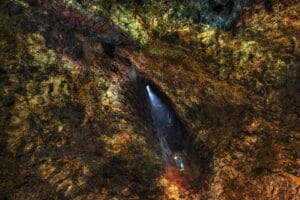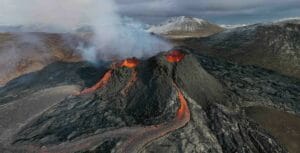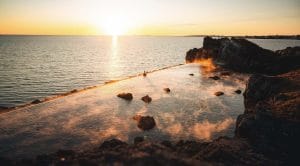Everything You Need to Know About the Northern Lights in Iceland
Iceland is a magical country that embraces stunning and incredible natural attractions. This Nordic island nation is home to dramatic landscapes, volcanoes, geothermal areas, natural glaciers, lava fields, hot springs, and great mountain peaks. Everything appears magical and mystical in this European country where you can find the best of mother nature. Travelers, trekkers, campers, hikers, explorers, and other adventure enthusiasts love this country for its beautiful natural surrounding and thrilling attractions which includes the Blue Lagoon, the Golden Circle, Snæfellsjökull national park, and the Northern Lights.
Iceland is well-known around the globe for its breath-taking and gorgeous Northern Lights. Every tourist from a different part of the world hopes to catch a glimpse of the natural light show. The sight is rare, which adds to its charm and popularity. It is one of the greatest and most beautiful natural show that you can witness on earth. The bright natural lights look magical and add to the beauty of Iceland. If you wish to catch a sight of this mystical scene, then take a note of the things below to be prepared not to miss the chance of capturing the picturesque scenery.

For Starters, Know What Northern Lights Are
Northern Lights are also known as Aurora Borealis (Dawn of the North) in Iceland; it is a spectacular night show that takes place during clear and dark nights during the winter. Typically, Northern lights are visible from mid-August to early April, when the weather is cold and nights are longer in Iceland. Aurora occurs high above the earth level in the sky, where the atmospheric layer becomes thin at a high altitude. A lot of science is involved in the phenomenon of the northern lights. In the literal term, the gaseous particles present in the earth’s atmosphere collide with the sun’s electrically charged particles that produce light. This light is called the northern light, generally of different shades of colors, including green, blue, violet, red and yellow.
The natives have other stories about the aurora borealis, some associate it with a mythological belief. Some American natives believe that viewing the northern lights in Norse mythology means having a glimpse of the Valkyries, a female warrior who lived and died in a battle. The Northern lights symbolize life after death, and in Europe and North America, it is also considered omens. Be it the scientific explanation or the mythological belief, what is promised is an unnatural and absolutely stunning scenery that is beyond any theory. If you get lucky enough to have a glance at the magical scene, capture it, and appreciate it for the rest of your life.

The Best Time to Experience the Northern Lights
It is slightly impossible to experience the auroras throughout the year; they are visible for a specific time between mid-August to early April. The lights majorly occur during dark winter nights on high latitude. The northern lights season coincides with the darker months, mainly during fall and winter. In the summer and spring season, the daylight tends to remain for longer hours, sometimes for more than 20 hours, making it impossible to witness the aurora borealis. The natural phenomenon is affected by other factors as well, including solar activity and cloudiness. The best time that has a major possibility of catching a glimpse of the stunning site is from end-September to March. This time frame has darker nights than usual, and the northern lights appear brighter and shiner due to that natural darkness. You need to get closer to the North pole to increase your chances of witnessing the northern lights. The hours around midnight with the highest latitude is the perfect time to look for the magical scene.
If we go by months, you should plan your trip accordingly by seeing the best possible time to experience the auroras. You may have fewer chances of seeing the northern lights in August as the natural daylight remains for a bit longer than other winter months; unless you get lucky depending on the favorable conditions. In September, the nights start to become longer, it’s not that cold, but the solar activity tends to increase, which is one factor that causes the natural lights to show. So, chances in September for seeing the lights gradually increase. The snowfalls start during the mid-October period, the nights get darker but are less cold than most winter months. The longer nights in November and December with high solar activity and cloudiness increase the chances of experiencing the bright and shinier natural lights. With heavy snowfall, the surface reacts as a reflector to the natural lights illuminating different corners, creating a mystical and picturesque scene. January is all about capturing the winter wonderland covered with a white blanket of snow. The entire island looks relishing covered with white beauty all around; the nights are longer with high solar activity and wild sky, which eventually adds to your luck to witness the scenic northern lights. The following months remain cold till April, the hours of light also start to increase, and as more tourists begin to travel to the country, the chances decrease to see the lights due to more artificial lights.
Throughout these winter months, the weather conditions in Iceland remains the worst. The chances of snowstorms and landslides are higher, ending up canceling some trips to the far north of the country. Roads closure happens some days during this time due to low natural light and heavy snowfall. You need to be careful before hitting the grounds to remain safe and sound in the unpredicted northern country. If you are traveling in the early hours looking for the auroras, make sure you dress accordingly as the weather during that time and month is way colder than you can assume.

The Ways to Experience the Northern Lights
Be open to experiment with the places and areas where you want to catch the northern lights. You can see the auroras from different parts and means; you just need to pick you’re most comfortable. Many travelers and explorers recommend that you go out of the capital city and try to catch the sight of the northern lights from a smaller town in the countryside. Cities often have more light pollution, which hinders the natural phenomenon’s occurrence. We always recommend that you try to get away from all light pollution to be able to experience the northern lights in the best way possible. The city has more people around, which makes the viewing experience noisy and crowded. Small towns or villages are generally quieter with only limited people, which means you can relax and enjoy the magical sight without any hassles. It would however be best to drive out of the towns and enjoy the northern lights in pure nature, away from all light pollution. The benefit of staying in the countryside is also adding to your traveling experience as you have more options for sightseeing while staying close to nature and the beautiful scenic landscapes.
You can also book a guided tour with a northern lights expert to have the best possible experience of watching the natural light show. The benefit of taking a tour is that you will be with guides that are a pro at helping you take a look at the mystical sight. They have seen the auroras before and know the weather conditions better. The guides spend their days watching the weather forecast and the aurora forecast so they will known exactly where to the best place is to spot the northern lights each night. Your guide can take you to places that have the best chances of witnessing the northern lights. Also, the local tour guides have way better road sense than you would have. The weather is extreme in winter, and having someone who knows the roads better can keep you safe on the dark drives and help you catch the sight of beautiful natural lights.
Iceland is not just about northern lights; the Nordic island embraces numerous landscapes with waterfalls, mountains, rivers, glacier lagoons, national parks, museums, and hot springs. The guides can take you to some of these popular attractions so that you can create the best memories of your expedition. Most importantly, tour guides can keep you safe by guiding you about everything that can come your way. Seeing the northern lights is possible only at a certain time, which means you need someone who can advise you to look ahead of the time to witness one of the best things on earth.
One of the most exciting and less discussed ways to explore the northern lights is traveling via boat. Boats or cruise ships can take you far north away from city pollution and noise. You can catch the most stunning views while on your voyage to the winter wonderland. Though the number of boats and cruise ships gets limited due to freezing temperatures, you can still enjoy the sight by pre-booking everything. The beauty of Iceland doubles up when you explore it while traveling via a boat as you get to see some visually appealing attractions. You will be away from the city, which means less light pollution and increasing chances of witnessing the north’s most incredible dawn. You might think that this experience is more expensive than the other northern lights tours, but the northern lights boat tours actually come at a great price. The peace and picturesque beauty on the boat make it worth giving a shot.

You Can Also Try….
To carefully and smartly plan your itinerary on your own. This means that you have to be a little flexible with your dates and stay if you’re adamant about experiencing the northern lights. Try to be close to the potential point where chances of catching the glimpse are higher, which means travel to Iceland for longer and darker nights. Take a good look at the weather forecast and aurora forecast to make sure that you know the best spots to see the northern lights. Ideally, September to April is not the best month for camping because of the cold weather during winter. But you can find a hotel or guesthouse out in the countryside and watch the northern lights from there. Or even go on short hikes to get away from the light pollution that comes from the hotel. The winter nights with twinkling stars dramatically adds to the chances of seeing the natural light show. This is both adventurous and aesthetically appealing. Spending the night under the bright winter moon, peace around, and hopefully the northern lights dancing above you is the most memorable moment you can take back from Iceland. You might have to stay up late because no one can predict the best time of the northern lights each night. You have to chase the lights and wait for a good amount of time to experience that once in a lifetime experience. The winter nights are darker and stay for over 20 hours, which means it adds to the opportunity even more.

Some Other Things That You Should Keep in Mind
While traveling to Iceland for experiencing the northern lights, do your research. Try to know the area better for a convenient traveling experience. As winter is the season of auroras, make sure you cover yourself in warm and extra layers to remain cozy and comfortable in the extreme weather conditions. Carry along with all the essential items you would require during your expedition, including a warm jacket, sturdy boots, extra food, guidebook, and road map. If you’re traveling with your family, especially kids, make sure to carry along all the necessary items you would require, as chasing the lights can be a tiring experience. Most travelers recommend conducting brief research before hitting the roads to chase the stunning northern lights. We always recommend that you check the weather forecast to know more about the cloud condition and positioning, and the aurora forecast before you head out. The activities in the sky and climatic conditions play a significant role in the northern lights’ occurrence. Compare the two forecasts and find the best spot to see the northern lights. Check out for clear skies on the weather forecast and northern lights on the aurora forecast. If the aurora forecast is above 3 -4 it means that the northern lights are likely to show up. Ensure you keep an eye on the forecast as you start your northern lights hunting, to plan your trip accordingly. Leave out the urban spaces and hit the countryside to chase the incredible lights. The more you stay away from the artificial lights of the city greater will be your chances of experiencing the light show on earth’s heaven.
At last, remember that you are in Iceland, and you have so much to explore. Don’t spend too much time chasing the lights. You can explore some breath-taking sites and attractions while in Iceland. The Nordic island promises a lifetime experience as you explore its luscious green hiking trails, gigantic mountains, rhythmic waterfalls, comforting hot springs, and magical rivers. Don’t miss any opportunity to travel through all of them to experience the best of mother nature. Plan your trip to be flexible in extending your trip to explore one of the most beautiful countries on earth and take a glance at the stunning natural light show. Just be patient while looking for the northern lights as it can be a tricky site, but it is definitely worth taking the efforts.




















































